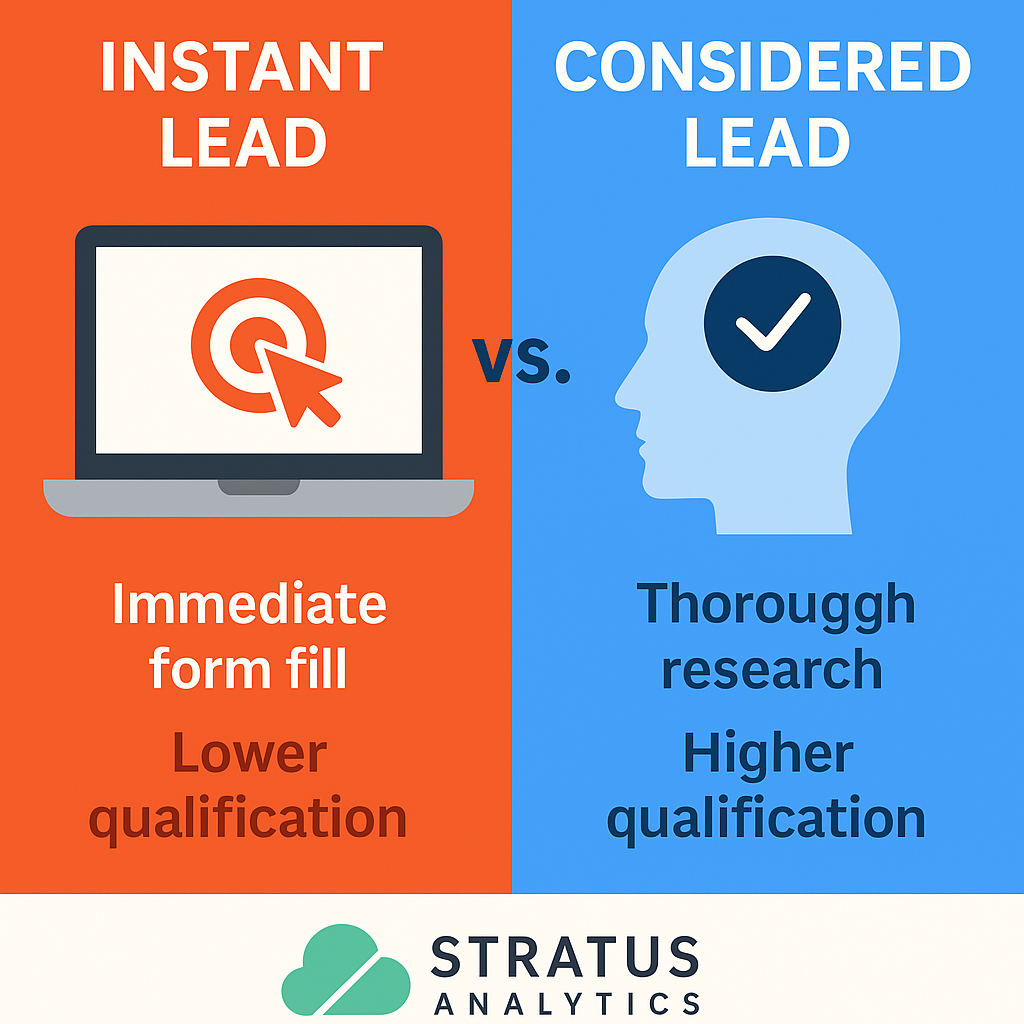When analyzing paid search performance, the focus often gravitates toward direct response metrics: click-through rates, conversion rates, and cost per lead. These numbers are important, but they can also be misleading when it comes to actual business outcomes. This is where direct response in paid search comes in to play.
A growing body of anecdotal evidence—and emerging client data—suggests that prospects who become leads after just one direct response interaction may close at a much lower rate than those who have multiple, more considered touch points before converting.
This has significant implications for how marketers should structure, evaluate, and optimize paid search campaigns.

The Two Types of Paid Search Leads
When a prospect interacts with a paid search ad, their next action typically falls into one of two categories:
1. The Instant Lead
This is the prospect who sees your ad, clicks on it, and immediately fills out a form. They might be impulsively motivated, intrigued by strong ad copy, or simply trying to gather more information quickly.
On the surface, this looks like a perfect interaction: minimal friction, immediate conversion, a clear return on ad spend.
However, instant leads often have not taken the time to thoroughly research or understand your offering. They may not be fully qualified, leading to higher drop-off rates later in the sales funnel.
2. The Considered Lead
This prospect behaves differently. After clicking on a paid search ad, they might read your landing page carefully, explore your website, review case studies, or compare your company against competitors. They may leave without converting immediately but return later—sometimes through organic search, direct visit, or even brand recall—to fill out your form when they feel more confident.
This type of lead typically demonstrates stronger intent and higher qualification levels because their decision-making process has involved deliberate research and self-selection.
Why Instant Leads Are Often Lower Quality
While instant conversions are attractive from a reporting perspective, they come with several potential downsides:
- Lower Commitment: An impulsive lead has not made a deep emotional or intellectual investment in your brand. They are more likely to disengage when faced with pricing, complexity, or alternatives.
- High Disqualification Rates: Sales teams may find themselves spending time with leads that are unqualified or not truly in-market.
- Wasted Spend: Optimizing exclusively for low-cost, quick conversions may inadvertently prioritize volume over quality, leading to inefficient budget usage.
When viewed through the full customer journey lens—not just the top-of-funnel—the costs of chasing instant leads can outweigh the initial benefits.
How Considered Leads Indicate Higher Intent
Prospects who take the time to self-educate are demonstrating a crucial behavior: commitment. They are investing their time and attention to learn about your offering, understand your value propositions, and verify whether your solution fits their needs.
Key advantages of considered leads include:
- Higher Close Rates: Sales teams have an easier time moving these leads through the pipeline because the prospect has already vetted your brand.
- Shorter Sales Cycles: Even though initial conversion took longer, these leads often move faster through later stages.
- Greater Lifetime Value: Thoughtful buyers are more likely to become loyal customers because their expectations were better managed.
This is why understanding lead journeys—not just lead volume—is critical to building a scalable, sustainable marketing engine.
Implications for Paid Search Strategy
If we accept that instant leads are generally lower quality and considered leads are higher quality, several important strategic adjustments follow:
1. Rethink Conversion Optimization Goals
Rather than optimizing solely for form fills, campaigns should consider deeper indicators of lead quality, such as:
- Repeat website visits before conversion
- Time on site
- Content engagement (e.g., case study downloads, pricing page views)
Campaign success metrics should be tied to meaningful engagement, not just first-click conversion rates.
2. Design for Research and Exploration
Landing pages and ad creative should support the prospect’s desire to learn and self-educate. Some ways to achieve this include:
- Offering rich, detailed content instead of aggressive short-form CTAs
- Providing clear next steps (e.g., “Learn More” or “See How It Works” instead of just “Get a Demo”)
- Making it easy for users to navigate to relevant resources like case studies, product comparisons, and FAQs
Creating an environment that encourages thoughtful exploration, rather than forcing immediate action, nurtures higher-quality leads.
3. Embrace Multi-Touch Attribution
Most traditional paid search reporting systems still focus heavily on last-click attribution. But if the most valuable leads require multiple touch points, marketers need to adopt attribution models that recognize and credit multi-stage journeys.
This could involve:
- Tracking returning visitors and second-session conversions
- Mapping user journeys across paid and organic channels
- Using CRM systems to connect marketing touch points to actual closed revenue
By evaluating the full journey, marketers can better understand which campaigns contribute to real business results, not just superficial lead counts.
4. Adjust Bidding Strategies Accordingly
If immediate form fills are not the ultimate goal, automated bidding strategies focused only on conversions (like Maximize Conversions or Target CPA) may work against lead quality goals.
Instead, marketers may benefit from:
- Custom bidding strategies that prioritize higher-value user actions
- Manual CPC bidding combined with strong audience segmentation
- Bidding more aggressively on keywords and audiences that show signals of deeper engagement
The shift moves from maximizing low-cost conversions to maximizing the right quality of engagement.
Testing and Validating This Hypothesis
While the intuition behind considered leads feels strong, it is critical to validate this assumption with real data.
Ways to test include:
- Segmenting leads based on conversion journey (instant vs. returning visitors)
- Measuring close rates, sales cycle length, and customer value for each group
- Analyzing CRM and attribution data to tie marketing behaviors to closed revenue
If early findings support the idea that instant leads close at significantly lower rates, it justifies a strategic shift toward valuing multi-touch, considered journeys even in traditionally direct-response-heavy channels like search.
A Mindset Shift for Paid Search
Paid search marketing has long been synonymous with direct response. But as markets mature and buying processes become more complex, a more nuanced approach is needed.
Rather than viewing quick conversions as the ultimate win, marketers should ask:
- Is this lead truly ready to buy?
- Have they meaningfully engaged with our brand?
- Will they advance easily through the sales pipeline?
Optimizing for thoughtful, considered leads—even if it means slightly lower initial conversion rates—could ultimately drive better business outcomes: higher close rates, better customer fit, and greater ROI.
In the end, not all conversions are created equal. It is time to build paid search strategies that recognize—and respect—the difference.

Hi there! I’m Scott, and I am the principal consultant and thought leader behind Stratus Analytics. I have a Master of Science degree in marketing analytics, and I’ve have been providing freelance digital marketing services for over 20 years. Additionally, I have written several books on marketing which you can find here on Amazon or this website.
DISCLAIMER: Due to my work in the packaging industry, I cannot take on freelance clients within the packaging manufacturing space. I do not want to provide disservice to your vision or my employer. Thank you for understanding.
